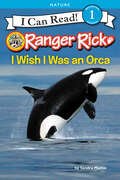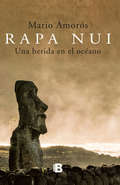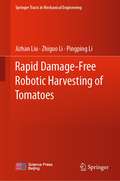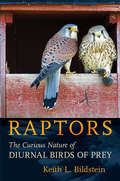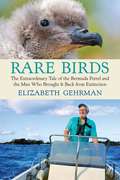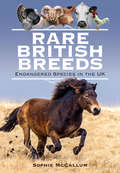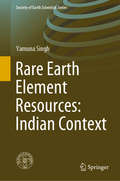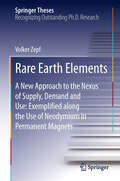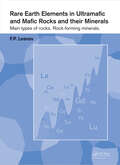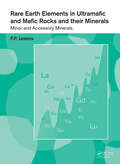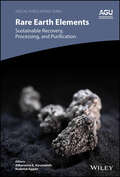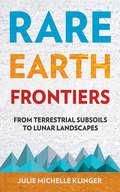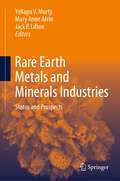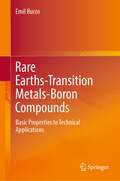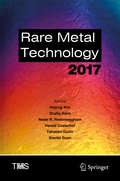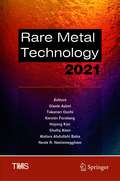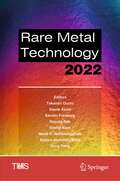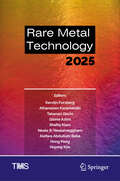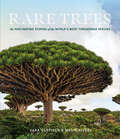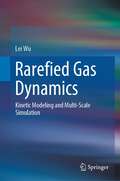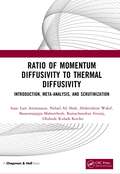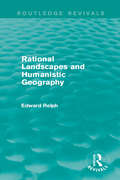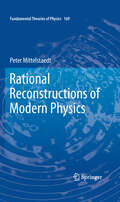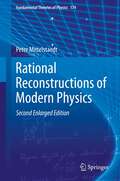- Table View
- List View
Ranger Rick: I Wish I Was an Orca (I Can Read Level 1)
by Sandra MarkleDive into the lives of orcas with Ranger Rick in this beginning reader with full-color photos of orcas in the wild! What if you wished you were an orca? And then you became one? An orca is an amazing kind of whale. Could you eat like an orca? Sleep like an orca? Live in an orca family? And would you want to? Find out! Ranger Rick explorers can learn all about orcas in this reader full of fascinating facts, vivid wildlife photographs, a Wild Words glossary, and a hands-on activity about how to communicate like an orca!Ranger Rick: I Wish I Was an Orca is a Level One I Can Read, which means it’s perfect for children learning to sound out words and sentences. Whether shared at home or in a classroom, the short sentences, familiar words, and simple concepts of Level One books support success for children eager to start reading on their own.
Rapa Nui: Una herida en el océano
by Mario AmorósUn libro revelador sobre un destino bello, en peligro y tan ajeno a la cultura nacional, pese a ser parte del territorio Libro que narra la historia y memoria del pueblo rapanui a partir de la documentación consultada en una decena de archivos, de una amplia bibliografía y de numerosos testimonios. <P><P>Entre el material inédito más relevante destaca la correspondencia del sacerdote capuchino alemán Sebastián Englert, destinado en la isla desde 1935, que da cuenta de la continuidad y de los cambios en la isla a lo largo de las décadas centrales del siglo XX. <P>Hace 130 años, los jefes rapanui, encabezados por el Ariki Atamu Tekena, otorgaron a Chile la soberanía sobre su isla. A cambio, el representante del Gobierno, el capitán de la Armada Policarpo Toro, les prometió respeto y protección. El llamado Acuerdo de Voluntades convirtió a Rapa Nui en una colonia que a partir de 1895 fue arrendada a una empresa privada, que la explotó como hacienda ovejera. En estos 130 años, el Estado chileno ha tenido una equívoca relación con la isla, al punto de ofrecerla en venta en plena segunda guerra mundial nada menos que a la Alemania nazi.
Rapid Damage-Free Robotic Harvesting of Tomatoes (Springer Tracts In Mechanical Engineering Ser.)
by Jizhan Liu Zhiguo Li Pingping LiThis book shares the latest findings on this topic, systematically introduces readers to advances made in robotic harvesting around the globe, and explores the relations between the development of robotic harvesting and the respective social/economic conditions and agricultural business patterns in various countries/regions. Due to the unstructured setting it is used in, and to the significant differences between individual fruit and vegetable targets, robotic harvesting is currently considered to be one of the most challenging robotics technologies. Accordingly, research into this area involves the integration of various aspects, including biomechanics, optimization design, advanced perception and intelligent control. <P><P> In addition to rapid and damage-free robotic harvesting, which reflects the multidisciplinary nature of the topic, further aspects addressed include gripping collisions with viscoelastic objects, using lasers to cut plant material, plant-fruit response to vacuum sucking and pulling, and performance probability distribution. Highlighting outstanding innovations and reflecting the latest advances in intelligent agricultural equipment in China, the book offers a unique and valuable resource.
Raptors: The Curious Nature of Diurnal Birds of Prey (Birdlife Conservation Ser. #Volume 9)
by Keith L. BildsteinRaptors are formally classified into five families and include birds—such as eagles, ospreys, kites, true hawks, buzzards, harriers, vultures, and falcons—that are familiar and recognized by many observers. These diurnal birds of prey are found on every continent except Antarctica and can thrive in seemingly inhospitable spots such as deserts and the tundra. They have powerful talons and hooked beaks for cutting and tearing meat, and keen binocular vision to aid in their hunting prowess. Because of their large size, distinctive feeding habits, and long-distance flight patterns, raptors intrigue humans and have been the subject of much general interest as well as extensive scientific research.Keith L. Bildstein has watched and studied raptors on five continents and is well prepared to explain their critical importance, not only as ecological entities but also as inspirational tokens across natural and human-dominated landscapes. His book offers a comprehensive and accessible account of raptors, including their evolutionary history, their relationships to other groups of birds, their sensory abilities, their general natural history, their breeding ecology and feeding behavior, and threats to their survival in a human-dominated world. Biologically sound but readable, Raptors is a nontechnical overview of this captivating group. It will allow naturalists, birders, hawk-watchers, science educators, schoolchildren, and the general public, along with new students in the field of raptor biology, to understand and appreciate these birds, and in so doing better protect them.
Rare Birds: The Extraordinary Tale of the Bermuda Petrel and the Man Who Brought It Back from Extinction
by Elizabeth GehrmanThe inspiring story of David Wingate, a living legend among birders, who brought the Bermuda petrel back from presumed extinction David Wingate is known in Bermuda as the birdman and in the international conservation community as a living legend for single-handedly bringing back the cahow, or Bermuda petrel—a seabird that flies up to 82,000 miles a year, drinking seawater and sleeping on the wing. For millennia, the birds came ashore every November to breed on this tiny North Atlantic island. But less than a decade after Bermuda’s 1612 settlement, the cahows had vanished. Or so it was thought until the early 1900s, when tantalizing hints of their continued existence began to emerge. In 1951, two scientists invited fifteen-year-old Wingate along on a bare-bones expedition to find the bird. The team stunned the world by locating seven nesting pairs, and Wingate knew his life had changed forever. He would spend the next fifty years battling natural and man-made disasters, bureaucracy, and personal tragedy with single-minded devotion and antiestablishment outspokenness. In April 2009, Wingate saw his dream fulfilled, as the birds returned to Nonsuch, an island habitat that he had hand-restored, plant-by-plant, giving the Bermuda petrels the chance they needed in their centuries-long fight for survival.
Rare British Breeds: Endangered Species in the UK
by Sophie McCallumA look at rare British livestock breeds, from their history and characteristics to their conservation status and the efforts to help them survive.Rare British Breeds is a book inspired by the Rare Breed Survival Trust Watchlist, which is published annually, listing the species of sheep, cattle, horses, pigs, goats and poultry (chickens, turkeys, ducks and geese) that are endangered in the United Kingdom.This information is gathered from breed societies and lists the number of breeding females alive, along with their conservation status. Each species, regardless of their origin, is unique to the UK, either through cross breeding or by evolution.There are good reasons for wanting to keep these breeds alive. It’s not just the genetic makeup of these creatures which means many are able to survive and thrive in very formidable conditions—a prerequisite for enduring possible future environmental disasters. Once gone, these genes will never be able to be replaced. They have taken thousands of years to develop.The book looks at the history of every breed, with their evolutionary roots, development over time, exportation, cross breeding, and changing relationship to mankind as farming techniques react to societal shifts. Their particular physical characteristics such as meat, wool, milk, eggs, or ability to pull great weights are discussed, as well as their conservation status and the national and international efforts being made to ensure their survival.
Rare Earth Element Resources: Indian Context (Society of Earth Scientists Series)
by Yamuna SinghThis volume presents a brief introduction to the Rare Earth Elements (REE) and their discovery, mineralogy, deposit types and applications. The book focusses on the aspects of both natural and industrial REE resources of India. It covers geological, structural, geochemical, petrological, mineralogical and genetic aspects of the natural deposits, and provides an account of the available industrial sources. The relative merits and potential of the several resources for future development and directions for inputs in REE exploration are discussed at the end of the monograph.
Rare Earth Elements
by Volker ZepfThis thesis deals with Rare Earth Elements (REE), especially with neodymium used in permanent magnets, from a very scientific basis by providing basic research data. Despite the fact that REE are newsworthy and very important elements for a considerable bandwidth of todays' technologies, accompanied by the monopolistic supply-situation and Chinese politics, there are inexplicable data discrepancies about REE which have been recognized frequently but usually have not been addressed accordingly. So this analysis started with the hypothesis that the four application areas, namely computer hard disk drives (HDD), mobile phones, wind turbines and e-mobility (automotive traction), account for about 80% of the global annual neodymium-demand. The research methodology was a laboratory analysis of the composition of used magnets for HDDs and mobile phones and a literature and official report analysis of wind turbine and automotive neodymium use. The result was amazing and the hypothesis had to be withdrawn as these four areas only account for about 20% of neodymium use. This result raises some questions concerning actual use and thus potential recycling options.
Rare Earth Elements in Ultramafic and Mafic Rocks and their Minerals: Main types of rocks. Rock-forming minerals
by Felix P. LesnovThis book gives an overview of the world�s literature on analytical data and theoretical concepts of the regularities of rare earth elements (REE) in ultramafic and mafic rocks of different chemical and mineral compositions � mantle restites (including those composing mantle xenoliths in alkali basaltoids), highly magnesium hypabyssal roc
Rare Earth Elements in Ultramafic and Mafic Rocks and their Minerals: Minor and Accessory Minerals
by Felix P. LesnovThis book presents an extensive overview of literature published globally in the last decades on REE distribution in minor and accessory minerals from various types of ultramafic, mafic, and other plutonic rocks. It is a continuation of the author‘s work published in 2010: Rare Earth Elements in Ultramafic and Mafic Rocks and their Minerals. Main T
Rare Earth Elements: Sustainable Recovery, Processing, and Purification (Special Publications #79)
by Athanasios K. Karamalidis Roderick EggertRare Earth Elements Sustainable Recovery, Processing, and Purification Rare earth elements are used in many modern technologies including electronics, clean energy, defense, aerospace, and automotive. It is important that increasing demand is met in ways that are more environmentally, socially, and economically sustainable than in the past. Rare Earth Elements: Sustainable Recovery, Processing, and Purification describes sources of rare earths and methods of production that have the potential to make recovery, processing, and purification more sustainable. Volume highlights include: Global overview of rare earth production, reserves, and resources Improvements in the recovery process to reduce costs and environmental impacts Potential new sources of rare earths that were not previously technically feasible Options for recovery of rare earths as byproducts of other activities Contributions from experts in academia, industry, government, research, and nonprofit organizations The American Geophysical Union promotes discovery in Earth and space science for the benefit of humanity. Its publications disseminate scientific knowledge and provide resources for researchers, students, and professionals.
Rare Earth Frontiers: From Terrestrial Subsoils to Lunar Landscapes
by Julie Michelle KlingerRare Earth Frontiers is a work of human geography that serves to demystify the powerful elements that make possible the miniaturization of electronics, green energy and medical technologies, and essential telecommunications and defense systems. Julie Michelle Klinger draws attention to the fact that the rare earths we rely on most are as common as copper or lead, and this means the implications of their extraction are global. Klinger excavates the rich historical origins and ongoing ramifications of the quest to mine rare earths in ever more impossible places.Klinger writes about the devastating damage to lives and the environment caused by the exploitation of rare earths. She demonstrates in human terms how scarcity myths have been conscripted into diverse geopolitical campaigns that use rare earth mining as a pretext to capture spaces that have historically fallen beyond the grasp of centralized power. These include legally and logistically forbidding locations in the Amazon, Greenland, and Afghanistan, and on the Moon. Drawing on ethnographic, archival, and interview data gathered in local languages and offering possible solutions to the problems it documents, this book examines the production of the rare earth frontier as a place, a concept, and a zone of contestation, sacrifice, and transformation.
Rare Earth Metals and Minerals Industries: Status and Prospects
by Yellapu V. Murty Mary Anne Alvin Jack P. LiftonThis book presents the current status and future prospects of rare earth elements with respect to a multitude of factors, including resource availability, production, and applications. Among the topics covered are the extraction of raw materials, alloying and compound production, applications, resource conservation through recycling, regulatory issues, and potential new resource streams. The chapters are authored by well-known technical experts in their fields, with decades of research, industrial, and governmental policy experience. The book is expected to serve as the first single source reference on rare earth minerals and metals aimed at students, scientists, technologists, government legislators, regulatory agencies, investors, and business leaders. It provides in-depth examination of the importance of rare earth elements to the global economy and their use in technological innovation, including energy, power, transportation, medicine, electronics, and chemical/petroleum industries.
Rare Earths-Transition Metals-Boron Compounds: Basic Properties to Technical Applications
by Emil BurzoThis book presents advances in the field of rare-earth (R) – transition metal (M) – boron compounds with extensive references. Since titanium and scandium do not form compounds with rare-earths, the Sc/Ti-M-B series are additionally presented. In each chapter the crystal structures, the complex physical properties as determined from neutron diffraction, magnetic measurements, resonance studies, transport properties and band structure calculations are critical analyzed. The models used in describing the experimental evidence are also presented. Tables with the main properties of the R-M-B compounds are given and representative data are illustrated in figures. In this way, the book provides state-of-the art knowledge and a valuable analysis of up-to-date results in the field. The technical applications, as permanent magnets, thermoelectric and magnetocaloric devices, hydrogen storage are also highlighted along with the authors insights into future directions in the field. The book is of interest for scientists involved in the development of the field as well as those working in the technical uses of rare-earth compounds.
Rare Metal Technology 2017
by Neale R. Neelameggham Hojong Kim Shafiq Alam Harald Oosterhof Takanari Ouchi Xiaofei GuanThis collection presents papers from a symposium on extraction of rare metals as well as rare extraction processing techniques used in metal production. Topics include the extraction and processing of elements like antimony, arsenic, gold, indium, palladium, platinum, rare earth metals including yttrium and neodymium, titanium, tungsten, and vanadium. Rare processing techniques are covered, including direct extraction processes for rare-earth recovery, biosorption of precious metals, fluorination behavior of uranium and zirconium mixture of fuel debris treatment, and recovery of valuable components of commodity metals such as zinc, nickel, and metals from slag.
Rare Metal Technology 2021 (The Minerals, Metals & Materials Series)
by Neale R. Neelameggham Hojong Kim Shafiq Alam Takanari Ouchi Gisele Azimi Alafara Abdullahi Baba Kerstin ForsbergThis collection presents papers from a symposium on extraction of rare metals as well as rare extraction processing techniques used in metal production. It covers metals essential for critical modern technologies including electronics, electric motors, generators, energy storage systems, and specialty alloys. Rare metals are the main building blocks of many emerging critical technologies and have been receiving significant attention in recent years. Much research in academia and industry is devoted to finding novel techniques to extract critical and rare metals from primary and secondary sources. The technologies that rely on critical metals are dominating the world, and finding a way to extract and supply them effectively is highly desirable and beneficial. Rapid development of these technologies entails fast advancement of the resource and processing industry for their building materials. Authors from academia and industry exchange knowledge on developing, operating, and advancing extractive and processing technologies. Contributions cover rare-earth elements (magnets, catalysts, phosphors, and others), energy storage materials (lithium, cobalt, vanadium, graphite), alloy elements (scandium, niobium, titanium), and materials for electronics (gallium, germanium, indium, gold, silver). The contributions also cover various processing techniques in mineral beneficiation, hydrometallurgy, separation and purification, pyrometallurgy, electrometallurgy, supercritical fluid extraction, and recycling (batteries, magnets, electrical and electronic equipment).
Rare Metal Technology 2022 (The Minerals, Metals & Materials Series)
by Neale R. Neelameggham Hojong Kim Shafiq Alam Takanari Ouchi Gisele Azimi Alafara Abdullahi Baba Kerstin Forsberg Hong PengThis collection presents papers from a symposium on extraction of rare metals from primary and secondary materials and residues as well as rare extraction processing techniques used in metal production. Authors cover the extraction of less common or minor metals including elements such as antimony, bismuth, barium, beryllium, boron, calcium, chromium, gallium, germanium, hafnium, indium, manganese, molybdenum, platinum group metals, rare earth metals, rhenium, scandium, selenium, sodium, strontium, tantalum, tellurium, and tungsten. Contributions also discuss rare metals of low-tonnage sales compared to high-tonnage metals (iron, copper, nickel, lead, tin, zinc, or light metals such as aluminum, magnesium, or titanium and electronic metalloid silicon). Authors also cover biometallurgy, hydrometallurgy, and electrometallurgy while novel high-temperature processes such as microwave heating, solar-thermal reaction synthesis, and cold crucible synthesis of rare metals are addressed. Also included in this collection is the design of extraction equipment used in these processes from suppliers as well as laboratory and pilot plant studies.
Rare Metal Technology 2025 (The Minerals, Metals & Materials Series)
by Neale R. Neelameggham Hojong Kim Shafiq Alam Takanari Ouchi Gisele Azimi Alafara Abdullahi Baba Kerstin Forsberg Hong Peng Athanasios KaramalidisThis volume presents papers from a symposium on extraction of rare metals from primary and secondary materials and residues as well as rare extraction processing techniques used in metal production. The collection covers the extraction of less common or minor metals including elements such as antimony, bismuth, barium, beryllium, boron, calcium, chromium, gallium, germanium, hafnium, indium, manganese, molybdenum, platinum group metals, rare earth metals, rhenium, scandium, selenium, sodium, strontium, tantalum, tellurium, and tungsten. It also includes rare metals of low-tonnage sales compared to high-tonnage metals (iron, copper, nickel, lead, tin, zinc, or light metals such as aluminum, magnesium, or titanium and electronic metalloid silicon). Rare metal processing covers biometallurgy, hydrometallurgy, and electrometallurgy while novel high-temperature processes such as microwave heating, solar-thermal reaction synthesis, and cold crucible synthesis of rare metals are also addressed. Also included in this collection is the design of extraction equipment used in these processes from suppliers as well as laboratory and pilot plant studies.
Rare Trees: The Fascinating Stories of the World's Most Threatened Species
by Sara Oldfield Malin RiversDiscover the secrets and beauty of the world&’s rarest trees in this fantastic book filled with more than 300 color photographs. Forests cover nearly a third of the world's surface, and the trees that make them up include a staggering diversity of more than 60,000 species. Individual trees play specific ecological roles in their unique environments—and they have adapted to thrive on steep mountains, in cloud forests, on dry savannahs, in parched deserts, and in tropical wetlands. Our history, and our future, are interwoven with the trees that define the regions of our green planet. Rare Trees profiles over 60 unique species that are currently endangered—including the most charismatic, fascinating, and downright bizarre examples from all around the globe. Filled with hundreds of color photographs, maps to help readers identify habitats, and accessible and engaging text by tree experts from the Global Trees Campaign, Rare Trees will give readers a new appreciation for the importance of trees and will inspire them to preserve this critical canopy of life.
Rarefied Gas Dynamics: Kinetic Modeling and Multi-Scale Simulation
by Lei WuThis book highlights a comprehensive description of the numerical methods in rarefied gas dynamics, which has strong applications ranging from space vehicle re-entry, micro-electromechanical systems, to shale gas extraction. The book consists of five major parts: The fast spectral method to solve the Boltzmann collision operator for dilute monatomic gas and the Enskog collision operator for dense granular gas; The general synthetic iterative scheme to solve the kinetic equations with the properties of fast convergence and asymptotic preserving; The kinetic modeling of monatomic and molecular gases, and the extraction of critical gas parameters from the experiment of Rayleigh-Brillouin scattering; The assessment of the fluid-dynamics equations derived from the Boltzmann equation and typical kinetic gas-surface boundary conditions;The applications of the fast spectral method and general synthetic iterative scheme to reveal the dynamics in some canonical rarefied gas flows. The book is suitable for postgraduates and researchers interested in rarefied gas dynamics and provides many numerical codes for them to begin with.
Ratings als Steuerungsinstrument von Unternehmen für eine nachhaltige Entwicklung
by Christian StrangaliesIn diesem Open-Access-Buch wird mit Hilfe einer systemtheoretischen Perspektive untersucht, wie Nachhaltigkeitsratings zu einer sinnvollen Gesellschaft beitragen. In einer grundlegenden Einführung in die Systemtheorie wird erklärt, wie die Selbsterhaltung von sozialen Systemen durch neuen Sinn ermöglicht wird, der auf weiteren Sinn verweist. Daraufhin wird die Notwendigkeit einer nachhaltigen Entwicklung der Gesellschaft systemtheoretisch dargestellt, indem ein pathologisches Wirtschaftssystem beschrieben wird, das die eigene Umwelt zerstört und dadurch immer weniger sinnvolle Anschlussoperationen findet, die weiteren Sinn ermöglichen. Zudem wird erläutert, wie aus systemtheoretischer Sicht ein nachhaltiges Wirtschaftssystem operiert. Es wird ausgeführt, wie durch eine begrenzte Reflexion neuer Sinn für das Wirtschaftssystem erzeugt wird, der im Einklang steht mit den gesellschaftlichen Entwicklungsmöglichkeiten und somit die wirtschaftliche und gesellschaftliche Selbsterhaltung langfristig sicherstellt. Anhand von Nachhaltigkeitsratings wird dann ein konkretes Beispiel angeführt, wie Entscheidungen mit einer begrenzten Reflexion in Unternehmen zu einer solchen sinnvollen Ökonomie beitragen.
Ratio of Momentum Diffusivity to Thermal Diffusivity: Introduction, Meta-analysis, and Scrutinization
by Isaac Lare Animasaun Nehad Ali Shah Abderrahim Wakif Basavarajappa Mahanthesh Ramachandran Sivaraj Olubode Kolade KorikoThis book presents a systematic introduction, practical meaning, and measurement of thermo-physical properties (i.e. viscosity, density, thermal conductivity, specific heat capacity, and thermal diffusivity) associated with the Prandtl number. The method of slope linear regression through the data points is presented in this textbook as a methodology for a deeper and insightful scrutinization. The book serves as a reference book for scientific investigators, Teachers of Fluid Mechanics, Experts on Heat and Mass Transfer, Researchers on Boundary layer flows, Mechanical and Chemical Engineers, Physicists, and Postgraduate Students working on transport phenomena who need theoretical and empirical reviews on the impact of increasing the ratio of momentum diffusivity to thermal diffusivity. Features: A systematic overview of the state-of-the-art in statistical methodology for understanding changes between dependent and independent variables. Pointers to some theoretical and empirical reviews on Prandtl number. Presents in-depth analysis of various self-similar flows, emphasizing stretching induced flows, nanofluid dynamics, suction, injection, free convection, mixed convection, and forced convection. Insightful study on thermal radiation, heat sour, heat sink, energy flux due to concentration gradient, mass flux due to temperature gradient, thermo-capillary convection flow, Joule heating, viscous dissipation, thermal stratification, thermophoresis, and Brownian motion of particles.
Rational Landscapes and Humanistic Geography (Routledge Revivals)
by Edward RelphThis book, first published in 1981, explores why it is that the modern built environment, while successfully providing material comfort and technical efficiency, none the less breeds despair and depression rather than inspires hope and commitment. The source of this paradox, where material benefits appear to have been gained only at the expense of intangible values and qualities is found in humanism, the persistent and powerful belief that all problems can be solved through the use of human reason. But humanism has become increasingly confused, rationalistic, callously devoted to efficiency, and authoritarian. These confusions and contradictions, together with the anti-nature stance of humanism and its failure to teach humane behaviour, lead the author to conclude that humanism is best rejected. Such rejection does not advocate the inhuman and anti-human, but requires instead a return to the ‘humility’ that lies at the origin of humanism – a respect for objects, creatures, environments and people. This ‘environmental humility’ is explored in the context of individuality of settings, ways of seeing landscapes, appropriation and ways of building places. This title will be of interest to students of human geography.
Rational Reconstructions of Modern Physics
by Peter MittelstaedtNewton’s classical physics and its underlying ontology are loaded with several metaphysical hypotheses that cannot be justified by rational reasoning nor by experimental evidence. Furthermore, it is well known that some of these hypotheses are not contained in the great theories of modern physics, such as the theory of relativity and quantum mechanics. This book shows that, on the basis of Newton’s classical physics and by rational reconstruction, the theory of relativity as well as quantum mechanics can be obtained by partly eliminating or attenuating the metaphysical hypotheses. Moreover, it is shown that these reconstructions do not require additional hypotheses or new experimental results.
Rational Reconstructions of Modern Physics, 2nd Enlarged Edition
by Peter MittelstaedtNewton's classical physics and its underlying ontology are loaded with several metaphysical hypotheses that cannot be justified by rational reasoning nor by experimental evidence. Furthermore, it is well known that some of these hypotheses are not contained in the great theories of Modern Physics, such as the theory of Special Relativity and Quantum Mechanics. This book shows that, on the basis of Newton's classical physics and by rational reconstruction, the theory of Special Relativity as well as Quantum Mechanics can be obtained by partly eliminating or attenuating the metaphysical hypotheses. Moreover, it is shown that these reconstructions do not require additional hypotheses or new experimental results. <P><P> In the second edition the rational reconstructions are completed with respect to General Relativity and Cosmology. In addition, the statistics of quantum objects is elaborated in more detail with respect to the rational reconstruction of quantum mechanics. The new material completes the approach of the book as much as it is possible at the present state of knowledge. Presumably, the most important contribution that is added to the second edition refers to the problem of interpretation of the three great theories of Modern Physics. It is shown in detail that in the light of rational reconstructions even realistic interpretations of the three theories of Modern Physics are possible and can easily be achieved.
